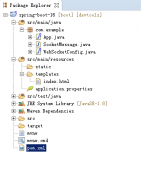摘要:最近有一个需求,为客户提供一些Restful API 接口,QA使用postman进行测试,但是postman的测试接口与java调用的相似但并不相同,于是想自己写一个程序去测试Restful API接口,由于使用的是HTTPS,所以还要考虑到对于HTTPS的处理。由于我也是首次使用Java调用restful接口,所以还要研究一番,自然也是查阅了一些资料。
分析:这个问题与模块之间的调用不同,比如我有两个模块front end 和back end,front end提供前台展示,back end提供数据支持。之前使用过Hession去把back end提供的服务注册成远程服务,在front end端可以通过这种远程服务直接调到back end的接口。但这对于一个公司自己的一个项目耦合性比较高的情况下使用,没有问题。但是如果给客户注册这种远程服务,似乎不太好,耦合性太高。所以就考虑用一下方式进行处理。
一、HttpClient
HttpClient大家也许比较熟悉但又比较陌生,熟悉是知道他可以远程调用比如请求一个URL,然后在response里获取到返回状态和返回信息,但是今天讲的稍微复杂一点,因为今天的主题是HTTPS,这个牵涉到证书或用户认证的问题。
确定使用HttpClient之后,查询相关资料,发现HttpClient的新版本与老版本不同,随然兼容老版本,但已经不提倡老版本是使用方式,很多都已经标记为过时的方法或类。今天就分别使用老版本4.2和最新版本4.5.3来写代码。
老版本4.2
需要认证
在准备证书阶段选择的是使用证书认证
|
1
2
3
4
5
6
7
8
9
10
11
12
13
14
15
16
17
18
19
20
21
22
23
24
25
|
package com.darren.test.https.v42; import java.io.File; import java.io.FileInputStream; import java.security.KeyStore; import org.apache.http.conn.ssl.SSLSocketFactory; public class HTTPSCertifiedClient extends HTTPSClient { public HTTPSCertifiedClient() { } @Override public void prepareCertificate() throws Exception { // 获得密匙库 KeyStore trustStore = KeyStore.getInstance(KeyStore.getDefaultType()); FileInputStream instream = new FileInputStream( new File("C:/Users/zhda6001/Downloads/software/xxx.keystore")); // FileInputStream instream = new FileInputStream(new File("C:/Users/zhda6001/Downloads/xxx.keystore")); // 密匙库的密码 trustStore.load(instream, "password".toCharArray()); // 注册密匙库 this.socketFactory = new SSLSocketFactory(trustStore); // 不校验域名 socketFactory.setHostnameVerifier(SSLSocketFactory.ALLOW_ALL_HOSTNAME_VERIFIER); } } |
跳过认证
在准备证书阶段选择的是跳过认证
|
1
2
3
4
5
6
7
8
9
10
11
12
13
14
15
16
17
18
19
20
21
22
23
24
25
26
27
28
29
30
31
32
33
34
35
36
|
package com.darren.test.https.v42; import java.security.cert.CertificateException; import java.security.cert.X509Certificate; import javax.net.ssl.SSLContext; import javax.net.ssl.TrustManager; import javax.net.ssl.X509TrustManager; import org.apache.http.conn.ssl.SSLSocketFactory; public class HTTPSTrustClient extends HTTPSClient { public HTTPSTrustClient() { } @Override public void prepareCertificate() throws Exception { // 跳过证书验证 SSLContext ctx = SSLContext.getInstance("TLS"); X509TrustManager tm = new X509TrustManager() { @Override public void checkClientTrusted(X509Certificate[] chain, String authType) throws CertificateException { } @Override public void checkServerTrusted(X509Certificate[] chain, String authType) throws CertificateException { } @Override public X509Certificate[] getAcceptedIssuers() { return null; } }; // 设置成已信任的证书 ctx.init(null, new TrustManager[] { tm }, null); // 穿件SSL socket 工厂,并且设置不检查host名称 this.socketFactory = new SSLSocketFactory(ctx, SSLSocketFactory.ALLOW_ALL_HOSTNAME_VERIFIER); } } |
总结
现在发现这两个类都继承了同一个类HTTPSClient,并且HTTPSClient继承了DefaultHttpClient类,可以发现,这里使用了模板方法模式。
|
1
2
3
4
5
6
7
8
9
10
11
12
13
14
15
16
17
18
19
20
21
22
23
24
25
26
27
28
29
30
31
32
33
34
35
36
37
|
package com.darren.test.https.v42; import org.apache.http.conn.ClientConnectionManager; import org.apache.http.conn.scheme.Scheme; import org.apache.http.conn.scheme.SchemeRegistry; import org.apache.http.conn.ssl.SSLSocketFactory; import org.apache.http.impl.client.DefaultHttpClient; public abstract class HTTPSClient extends DefaultHttpClient { protected SSLSocketFactory socketFactory; /** * 初始化HTTPSClient * * @return 返回当前实例 * @throws Exception */ public HTTPSClient init() throws Exception { this.prepareCertificate(); this.regist(); return this; } /** * 准备证书验证 * * @throws Exception */ public abstract void prepareCertificate() throws Exception; /** * 注册协议和端口, 此方法也可以被子类重写 */ protected void regist() { ClientConnectionManager ccm = this.getConnectionManager(); SchemeRegistry sr = ccm.getSchemeRegistry(); sr.register(new Scheme("https", 443, socketFactory)); } } |
下边是工具类
|
1
2
3
4
5
6
7
8
9
10
11
12
13
14
15
16
17
18
19
20
21
22
23
24
25
26
27
28
29
30
31
32
33
34
35
36
37
38
39
40
41
42
43
44
45
46
47
48
49
50
51
52
53
54
55
56
57
58
59
60
61
62
63
64
65
66
67
68
69
70
71
72
73
74
75
76
77
78
79
80
81
82
83
84
85
86
87
88
89
|
package com.darren.test.https.v42; import java.util.ArrayList; import java.util.List; import java.util.Map; import java.util.Set; import org.apache.http.HttpEntity; import org.apache.http.HttpResponse; import org.apache.http.NameValuePair; import org.apache.http.client.entity.UrlEncodedFormEntity; import org.apache.http.client.methods.HttpGet; import org.apache.http.client.methods.HttpPost; import org.apache.http.client.methods.HttpRequestBase; import org.apache.http.message.BasicNameValuePair; import org.apache.http.util.EntityUtils; public class HTTPSClientUtil { private static final String DEFAULT_CHARSET = "UTF-8"; public static String doPost(HTTPSClient httpsClient, String url, Map<String, String> paramHeader, Map<String, String> paramBody) throws Exception { return doPost(httpsClient, url, paramHeader, paramBody, DEFAULT_CHARSET); } public static String doPost(HTTPSClient httpsClient, String url, Map<String, String> paramHeader, Map<String, String> paramBody, String charset) throws Exception { String result = null; HttpPost httpPost = new HttpPost(url); setHeader(httpPost, paramHeader); setBody(httpPost, paramBody, charset); HttpResponse response = httpsClient.execute(httpPost); if (response != null) { HttpEntity resEntity = response.getEntity(); if (resEntity != null) { result = EntityUtils.toString(resEntity, charset); } } return result; } public static String doGet(HTTPSClient httpsClient, String url, Map<String, String> paramHeader, Map<String, String> paramBody) throws Exception { return doGet(httpsClient, url, paramHeader, paramBody, DEFAULT_CHARSET); } public static String doGet(HTTPSClient httpsClient, String url, Map<String, String> paramHeader, Map<String, String> paramBody, String charset) throws Exception { String result = null; HttpGet httpGet = new HttpGet(url); setHeader(httpGet, paramHeader); HttpResponse response = httpsClient.execute(httpGet); if (response != null) { HttpEntity resEntity = response.getEntity(); if (resEntity != null) { result = EntityUtils.toString(resEntity, charset); } } return result; } private static void setHeader(HttpRequestBase request, Map<String, String> paramHeader) { // 设置Header if (paramHeader != null) { Set<String> keySet = paramHeader.keySet(); for (String key : keySet) { request.addHeader(key, paramHeader.get(key)); } } } private static void setBody(HttpPost httpPost, Map<String, String> paramBody, String charset) throws Exception { // 设置参数 if (paramBody != null) { List<NameValuePair> list = new ArrayList<NameValuePair>(); Set<String> keySet = paramBody.keySet(); for (String key : keySet) { list.add(new BasicNameValuePair(key, paramBody.get(key))); } if (list.size() > 0) { UrlEncodedFormEntity entity = new UrlEncodedFormEntity(list, charset); httpPost.setEntity(entity); } } } } |
然后是测试类:
|
1
2
3
4
5
6
7
8
9
10
11
12
13
14
15
16
17
18
19
20
21
22
23
24
25
26
|
package com.darren.test.https.v42; import java.util.HashMap; import java.util.Map; public class HTTPSClientTest { public static void main(String[] args) throws Exception { HTTPSClient httpsClient = null; httpsClient = new HTTPSTrustClient().init(); //httpsClient = new HTTPSCertifiedClient().init(); String url = "https://1.2.6.2:8011/xxx/api/getToken"; //String url = "https://1.2.6.2:8011/xxx/api/getHealth"; Map<String, String> paramHeader = new HashMap<>(); //paramHeader.put("Content-Type", "application/json"); paramHeader.put("Accept", "application/xml"); Map<String, String> paramBody = new HashMap<>(); paramBody.put("client_id", "ankur.tandon.ap@xxx.com"); paramBody.put("client_secret", "P@ssword_1"); String result = HTTPSClientUtil.doPost(httpsClient, url, paramHeader, paramBody); //String result = HTTPSClientUtil.doGet(httpsClient, url, null, null); System.out.println(result); } } |
返回信息:
<?xml version="1.0" encoding="utf-8"?>
<token>jkf8RL0sw+Skkflj8RbKI5hP1bEQK8PrCuTZPpBINqMYKRMxY1kWCjmCfT191Zpp88VV1aGHW8oYNWjEYS0axpLuGAX89ejCoWNbikCc1UvfyesXHLktcJqyUFiVjevhrEQxJPHncLQYWP+Xse5oD9X8vKFKk7InNTMRzQK7YBTZ/e3U7gswM/5cvAHFl6o9rEq9cWPXavZNohyvnXsohSzDo+BXAtXxa1xpEDLy/8h/UaP4n4dlZDJJ3B8t1Xh+CRRIoMOPxf7c5wKhHtOkEOeXW+xoPQKKSx5CKWwJpPuGIIFWF/PaqWg+JUOsVT7QGdPv8PMWJ9DwEwjTdxguDg==</token>
新版本4.5.3
需要认证
|
1
2
3
4
5
6
7
8
9
10
11
12
13
14
15
16
17
18
19
20
21
22
23
24
25
26
27
28
29
30
31
|
package com.darren.test.https.v45; import java.io.File; import java.io.FileInputStream; import java.security.KeyStore; import javax.net.ssl.SSLContext; import org.apache.http.conn.ssl.SSLConnectionSocketFactory; import org.apache.http.conn.ssl.TrustSelfSignedStrategy; import org.apache.http.ssl.SSLContexts; public class HTTPSCertifiedClient extends HTTPSClient { public HTTPSCertifiedClient() { } @Override public void prepareCertificate() throws Exception { // 获得密匙库 KeyStore trustStore = KeyStore.getInstance(KeyStore.getDefaultType()); FileInputStream instream = new FileInputStream( new File("C:/Users/zhda6001/Downloads/software/xxx.keystore")); // FileInputStream instream = new FileInputStream(new File("C:/Users/zhda6001/Downloads/xxx.keystore")); try { // 密匙库的密码 trustStore.load(instream, "password".toCharArray()); } finally { instream.close(); } SSLContext sslcontext = SSLContexts.custom().loadTrustMaterial(trustStore, TrustSelfSignedStrategy.INSTANCE) .build(); this.connectionSocketFactory = new SSLConnectionSocketFactory(sslcontext); } } |
跳过认证
|
1
2
3
4
5
6
7
8
9
10
11
12
13
14
15
16
17
18
19
20
21
22
23
24
25
26
27
28
29
30
31
32
33
34
|
package com.darren.test.https.v45; import java.security.cert.CertificateException; import java.security.cert.X509Certificate; import javax.net.ssl.SSLContext; import javax.net.ssl.TrustManager; import javax.net.ssl.X509TrustManager; import org.apache.http.conn.ssl.SSLConnectionSocketFactory; public class HTTPSTrustClient extends HTTPSClient { public HTTPSTrustClient() { } @Override public void prepareCertificate() throws Exception { // 跳过证书验证 SSLContext ctx = SSLContext.getInstance("TLS"); X509TrustManager tm = new X509TrustManager() { @Override public void checkClientTrusted(X509Certificate[] chain, String authType) throws CertificateException { } @Override public void checkServerTrusted(X509Certificate[] chain, String authType) throws CertificateException { } @Override public X509Certificate[] getAcceptedIssuers() { return null; } }; // 设置成已信任的证书 ctx.init(null, new TrustManager[] { tm }, null); this.connectionSocketFactory = new SSLConnectionSocketFactory(ctx); } } |
总结
|
1
2
3
4
5
6
7
8
9
10
11
12
13
14
15
16
17
18
19
20
21
22
23
24
25
26
27
28
29
30
31
32
33
34
35
36
37
38
39
40
41
42
43
44
45
46
47
48
49
50
|
package com.darren.test.https.v45; import org.apache.http.config.Registry; import org.apache.http.config.RegistryBuilder; import org.apache.http.conn.socket.ConnectionSocketFactory; import org.apache.http.conn.socket.PlainConnectionSocketFactory; import org.apache.http.impl.client.CloseableHttpClient; import org.apache.http.impl.client.HttpClientBuilder; import org.apache.http.impl.client.HttpClients; import org.apache.http.impl.conn.PoolingHttpClientConnectionManager; public abstract class HTTPSClient extends HttpClientBuilder { private CloseableHttpClient client; protected ConnectionSocketFactory connectionSocketFactory; /** * 初始化HTTPSClient * * @return 返回当前实例 * @throws Exception */ public CloseableHttpClient init() throws Exception { this.prepareCertificate(); this.regist(); return this.client; } /** * 准备证书验证 * * @throws Exception */ public abstract void prepareCertificate() throws Exception; /** * 注册协议和端口, 此方法也可以被子类重写 */ protected void regist() { // 设置协议http和https对应的处理socket链接工厂的对象 Registry<ConnectionSocketFactory> socketFactoryRegistry = RegistryBuilder.<ConnectionSocketFactory>create() .register("http", PlainConnectionSocketFactory.INSTANCE) .register("https", this.connectionSocketFactory) .build(); PoolingHttpClientConnectionManager connManager = new PoolingHttpClientConnectionManager(socketFactoryRegistry); HttpClients.custom().setConnectionManager(connManager); // 创建自定义的httpclient对象 this.client = HttpClients.custom().setConnectionManager(connManager).build(); // CloseableHttpClient client = HttpClients.createDefault(); } } |
工具类:
|
1
2
3
4
5
6
7
8
9
10
11
12
13
14
15
16
17
18
19
20
21
22
23
24
25
26
27
28
29
30
31
32
33
34
35
36
37
38
39
40
41
42
43
44
45
46
47
48
49
50
51
52
53
54
55
56
57
58
59
60
61
62
63
64
65
66
67
68
69
70
71
72
73
74
75
76
77
78
79
80
81
82
83
84
85
86
87
88
89
|
package com.darren.test.https.v45; import java.util.ArrayList; import java.util.List; import java.util.Map; import java.util.Set; import org.apache.http.HttpEntity; import org.apache.http.HttpResponse; import org.apache.http.NameValuePair; import org.apache.http.client.HttpClient; import org.apache.http.client.entity.UrlEncodedFormEntity; import org.apache.http.client.methods.HttpGet; import org.apache.http.client.methods.HttpPost; import org.apache.http.client.methods.HttpRequestBase; import org.apache.http.message.BasicNameValuePair; import org.apache.http.util.EntityUtils; public class HTTPSClientUtil { private static final String DEFAULT_CHARSET = "UTF-8"; public static String doPost(HttpClient httpClient, String url, Map<String, String> paramHeader, Map<String, String> paramBody) throws Exception { return doPost(httpClient, url, paramHeader, paramBody, DEFAULT_CHARSET); } public static String doPost(HttpClient httpClient, String url, Map<String, String> paramHeader, Map<String, String> paramBody, String charset) throws Exception { String result = null; HttpPost httpPost = new HttpPost(url); setHeader(httpPost, paramHeader); setBody(httpPost, paramBody, charset); HttpResponse response = httpClient.execute(httpPost); if (response != null) { HttpEntity resEntity = response.getEntity(); if (resEntity != null) { result = EntityUtils.toString(resEntity, charset); } } return result; } public static String doGet(HttpClient httpClient, String url, Map<String, String> paramHeader, Map<String, String> paramBody) throws Exception { return doGet(httpClient, url, paramHeader, paramBody, DEFAULT_CHARSET); } public static String doGet(HttpClient httpClient, String url, Map<String, String> paramHeader, Map<String, String> paramBody, String charset) throws Exception { String result = null; HttpGet httpGet = new HttpGet(url); setHeader(httpGet, paramHeader); HttpResponse response = httpClient.execute(httpGet); if (response != null) { HttpEntity resEntity = response.getEntity(); if (resEntity != null) { result = EntityUtils.toString(resEntity, charset); } } return result; } private static void setHeader(HttpRequestBase request, Map<String, String> paramHeader) { // 设置Header if (paramHeader != null) { Set<String> keySet = paramHeader.keySet(); for (String key : keySet) { request.addHeader(key, paramHeader.get(key)); } } } private static void setBody(HttpPost httpPost, Map<String, String> paramBody, String charset) throws Exception { // 设置参数 if (paramBody != null) { List<NameValuePair> list = new ArrayList<NameValuePair>(); Set<String> keySet = paramBody.keySet(); for (String key : keySet) { list.add(new BasicNameValuePair(key, paramBody.get(key))); } if (list.size() > 0) { UrlEncodedFormEntity entity = new UrlEncodedFormEntity(list, charset); httpPost.setEntity(entity); } } } } |
测试类:
|
1
2
3
4
5
6
7
8
9
10
11
12
13
14
15
16
17
18
19
20
21
22
23
24
25
26
27
|
package com.darren.test.https.v45; import java.util.HashMap; import java.util.Map; import org.apache.http.client.HttpClient; public class HTTPSClientTest { public static void main(String[] args) throws Exception { HttpClient httpClient = null; //httpClient = new HTTPSTrustClient().init(); httpClient = new HTTPSCertifiedClient().init(); String url = "https://1.2.6.2:8011/xxx/api/getToken"; //String url = "https://1.2.6.2:8011/xxx/api/getHealth"; Map<String, String> paramHeader = new HashMap<>(); paramHeader.put("Accept", "application/xml"); Map<String, String> paramBody = new HashMap<>(); paramBody.put("client_id", "ankur.tandon.ap@xxx.com"); paramBody.put("client_secret", "P@ssword_1"); String result = HTTPSClientUtil.doPost(httpClient, url, paramHeader, paramBody); //String result = HTTPSClientUtil.doGet(httpsClient, url, null, null); System.out.println(result); } } |
结果:
<?xml version="1.0" encoding="utf-8"?>
<token>RxitF9//7NxwXJS2cjIjYhLtvzUNvMZxxEQtGN0u07sC9ysJeIbPqte3hCjULSkoXPEUYGUVeyI9jv7/WikLrzxYKc3OSpaTSM0kCbCKphu0TB2Cn/nfzv9fMLueOWFBdyz+N0sEiI9K+0Gp7920DFEncn17wUJVmC0u2jwvM5FAjQKmilwodXZ6a0Dq+D7dQDJwVcwxBvJ2ilhyIb3pr805Vppmi9atXrVAKO0ODa006wEJFOfcgyG5p70wpJ5rrBL85vfy9WCvkd1R7j6NVjhXgH2gNimHkjEJorMjdXW2gKiUsiWsELi/XPswao7/CTWNwTnctGK8PX2ZUB0ZfA==</token>
二、HttpURLConnection
三、Spring的RestTemplate
其它方式以后补充
以上就是本文的全部内容,希望对大家的学习有所帮助,也希望大家多多支持服务器之家。
原文链接:http://blog.csdn.net/zpf336/article/details/73480810














